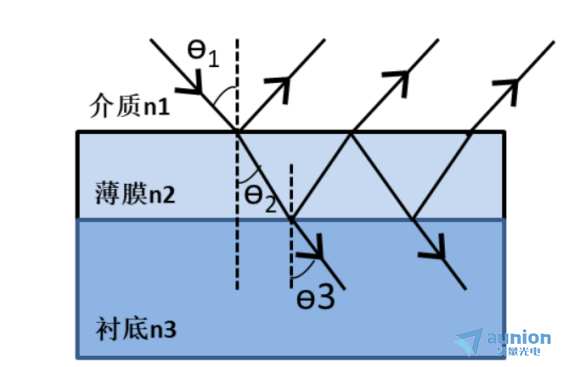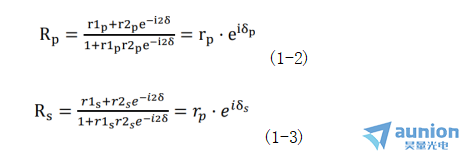

椭偏谱是一种无损测量技术可应用于薄膜光学常数及厚度等的测量。椭偏谱目前已经被应用于真空薄膜的在位监控,比如磁控溅射,原子层沉积(ALD)和分子束外延(MBE)等。通过椭偏仪的在位监测及建模拟合可以实时解构出未知成分的光学常数、厚度以及生长模式。但是利用椭偏仪在位监测电化学沉积极具挑战性,面临着溶液界面、实验装置和拟合模型的影响。
展示全部 
椭偏仪在位表征电化学沉积的系统搭建(一)-基本原理
利用椭偏仪可以精确测量薄膜的厚度和光学常数,其测量原理基于不同偏振光(S,P)与材料的作用。如图1-1所示的单层薄膜模型中,所测的薄膜在衬底上,zui上层为空气,薄膜两侧介质都是半无限大,且薄膜上下表面皆是理想光滑表面,三种介质皆为均匀、各向同性介质。在实际测量过程中,单层模型的三种介质通常指的是空气、待测薄膜和基底。

图1-1 光波在多层膜上的反射与透射
光波在单层膜上的反射和透射示意图如图1-1所示。定义入射光波矢量E在垂直于入射面上的分量为P光,在入射面上的分量为S光。
由折射定律及菲涅耳定律知 、
、 、
、 的关系为:
的关系为:

上述式子中,n1是空气的折射率(1.00),n2是薄膜的折射率,n3是衬底折射率, 是光在界面1的入射角,
是光在界面1的入射角, 、
、 如图1-1所示,分别是在所测薄膜、基底中的折射角。在图1-1的模型中,经过多次反射折射后,由多光干涉的公式可得zui终反射系数为:
如图1-1所示,分别是在所测薄膜、基底中的折射角。在图1-1的模型中,经过多次反射折射后,由多光干涉的公式可得zui终反射系数为:

其中 ,d是膜厚,λ是真空中光的波长,2δ是相邻两束反射光的相位差。
,d是膜厚,λ是真空中光的波长,2δ是相邻两束反射光的相位差。
振幅、相位是描述光波偏振状态的两个参数,在椭偏仪中用Ψ、△来表示。其取值范围是:0≤Ψ≤π/2,0≤△<2π。总反射系数比值定义为ρ,ρ与(Ψ,△)、(Rp,Rs)关系式如下:

其中,tgΨ为反射前后P、S光两分量的振幅衰减比,△=δp−δs为P、S两分量相位变化差。
可以清楚地看到Ψ、△直接给出反射前和反射后光偏振状态变化。在衬底、入射角、波长等确定已知的条件下,Ψ、△是膜厚d和薄膜折射率n的函数,可表示为下式:

由上式可知薄膜反射后,椭偏光偏振状态发生改变,成为另一种椭偏光。测量过程中,对起偏器方位角p进行调节,使得反射得到的椭偏光变成线性偏振光;再通过检偏器的方位角A调节,得到消光状态。此时,薄膜的厚度d与折射率n为起偏器方位角p和检偏器的方位角A的函数,可写成如下一般函数式为:

对式(1-6)的处理是在没有具体函数的情况之下,利用(1-1)~(1-2)式,列出(P,A)~(d,n)的数表,再根据消光状态下得到的(P,A)值,找到相应膜厚d与其折射率n。通常消光状态有许多个,所以可以通过多次测量得到一系列(P,A)值及其对应的(d,n),zui后多值求平均得到的结果更为准确。
要从椭偏仪测量数据中得到厚度、光学常数等信息,则要对测试得到的椭偏实验数据进行模拟。所以椭偏仪数据的模型建立和拟合是至关重要的一步。常见的椭偏仪数据分析模型有NK模型、柯西模型、柯西指数模型、Sellmeier模型、Lorentz-Lorenz Oscillator模型、Maxwell-Garnett有效介质模型、Bruggeman有效介质模型、Graded模型、Drude模型、洛仑兹振子模型、Forouhi Bloomer模型。下面介绍一下有效介质(EMA)模型和Drude+Lorentz Oscillator模型。
EMA(有效介质)模型:有效介质模型适用于复合材料具有多种组分的情况。其中复合的介电常数是由各个组分的介电常数线性叠加而成,且与成分的形状有关。EMA模型的常见表达式:

其中 是复合介质的介电函数,fi和
是复合介质的介电函数,fi和 是某一组分的体积分数和介电函数,
是某一组分的体积分数和介电函数, 是底介电函数,m是各组分的数量,Y是与颗粒的形状有的关屏蔽因子。用有效质模型可以解构表面的成核和生长,以及表面的粗糙度等。
是底介电函数,m是各组分的数量,Y是与颗粒的形状有的关屏蔽因子。用有效质模型可以解构表面的成核和生长,以及表面的粗糙度等。
Drude+Lorentz Oscillator模型:一般来讲金属中费米面附近的电子视为自由电子,其介电常数可以用自由电子模型进行描述。但是对于金属比如贵金属Au,Ag,Cu在其高频部分,还会出现带间跃迁。因此对于金属和载流子浓度较高的半导体材料,其介电常数可以用Drude+Lorentz Oscillator模型模型进行描述:

其中 为高频晶格介电常数,wp为等离子体频率,v为阻尼频率,Ecenter r为振子的中心能量,Aj为j振子的振幅。Aj振幅和横向和纵向的声子频率有关,
为高频晶格介电常数,wp为等离子体频率,v为阻尼频率,Ecenter r为振子的中心能量,Aj为j振子的振幅。Aj振幅和横向和纵向的声子频率有关, ,其中WL为横向声子频率,为纵WT向声子频率。m为振子的数目。
,其中WL为横向声子频率,为纵WT向声子频率。m为振子的数目。
了解更多详情,请访问上海昊量光电的官方网页:
https://www.auniontech.com/three-level-56.html
更多详情请联系昊量光电/欢迎直接联系昊量光电
关于昊量光电:
上海昊量光电设备有限公司是光电产品专业代理商,产品包括各类激光器、光电调制器、光学测量设备、光学元件等,涉及应用涵盖了材料加工、光通讯、生物医疗、科学研究、国防、量子光学、生物显微、物联传感、激光制造等;可为客户提供完整的设备安装,培训,硬件开发,软件开发,系统集成等服务。
您可以通过我们昊量光电的官方网站www.auniontech.com了解更多的产品信息,或直接来电咨询4006-888-532。
相关文献:
[1] WONG H S P, FRANK D J, SOLOMON P M et al. Nanoscale cmos[J]. Proceedings of the IEEE, 1999, 87(4): 537-570.
[2] LOSURDO M, HINGERL K. ellipsometry at the nanoscale[M]. Springer Heidelberg New York Dordrecht London. 2013.
[3] DYRE J C. Universal low-temperature ac conductivity of macroscopically disordered nonmetals[J]. Physical Review B, 1993, 48(17): 12511-12526. DOI:10.1103/PhysRevB.48.12511.
[4] CHEN S, KÜHNE P, STANISHEV V et al. On the anomalous optical conductivity dISPersion of electrically conducting polymers: Ultra-wide spectral range ellipsometry combined with a Drude-Lorentz model[J]. Journal of Materials Chemistry C, 2019, 7(15): 4350-4362.
[5] 陈篮,周岩. 膜厚度测量的椭偏仪法原理分析[J]. 大学物理实验, 1999, 12(3): 10-13.
[6] ZAPIEN J A, COLLINS R W, MESSIER R. Multichannel ellipsometer for real time spectroscopy of thin film deposition from 1.5 to 6.5 eV[J]. Review of Scientific Instruments, 2000, 71(9): 3451-3460.
[7] DULTSEV F N, KOLOSOVSKY E A. Application of ellipsometry to control the plasmachemical synthesis of thin TiONx layers[J]. Advances in Condensed Matter Physics, 2015, 2015: 1-8.
[8] DULTSEV F N, KOLOSOVSKY E A. Application of ellipsometry to control the plasmachemical synthesis of thin TiONx layers[J]. Advances in Condensed Matter Physics, 2015, 2015: 1-8.
[9] YUAN M, YUAN L, HU Z et al. In Situ Spectroscopic Ellipsometry for Thermochromic CsPbI3 Phase Evolution Portfolio[J]. Journal of Physical Chemistry C, 2020, 124(14): 8008-8014.
[10] 焦杨景.椭偏仪在位表征电化学沉积的系统搭建.云南大学说是论文,2022.
[11] CANEPA M, MAIDECCHI G, TOCCAFONDI C et al. Spectroscopic ellipsometry of self assembLED monolayers: Interface effects. the case of phenyl selenide SAMs on gold[J]. Physical Chemistry Chemical Physics, 2013, 15(27): 11559-11565. DOI:10.1039/c3cp51304a.
[12] FUJIWARA H, KONDO M, MATSUDA A. Interface-layer formation in microcrystalline Si:H growth on ZnO substrates studied by real-time spectroscopic ellipsometry and infrared spectroscopy[J]. Journal of Applied Physics, 2003, 93(5): 2400-2409.
[13] FUJIWARA H, TOYOSHIMA Y, KONDO M et al. Interface-layer formation mechanism in (formula presented) thin-film growth studied by real-time spectroscopic ellipsometry and infrared spectroscopy[J]. Physical Review B - Condensed Matter and Materials Physics, 1999, 60(19): 13598-13604.
[14] LEE W K, KO J S. Kinetic model for the simulation of hen egg white lysozyme adsorption at solid/water interface[J]. Korean Journal of Chemical Engineering, 2003, 20(3): 549-553.
[15] STAMATAKI K, PAPADAKIS V, EVEREST M A et al. Monitoring adsorption and sedimentation using evanescent-wave cavity ringdown ellipsometry[J]. Applied Optics, 2013, 52(5): 1086-1093.
[16] VIEGAS D, FERNANDES E, QUEIRÓS R et al. Adapting Bobbert-Vlieger model to spectroscopic ellipsometry of gold nanoparticles with bio-organic shells[J]. Biomedical Optics Express, 2017, 8(8): 3538.
[17] ARWIN H. Application of ellipsometry techniques to biological materials[J]. Thin Solid Films, 2011, 519(9): 2589-2592.
[18] ZIMMER A, VEYS-RENAUX D, BROCH L et al. In situ spectroelectrochemical ellipsometry using super continuum white laser: Study of the anodization of magnesium alloy [J]. Journal of Vacuum Science & Technology B, 2019, 37(6): 062911.
[19] ZANGOOIE S, BJORKLUND R, ARWIN H. Water Interaction with Thermally Oxidized Porous Silicon Layers[J]. Journal of The Electrochemical Society, 1997, 144(11): 4027-4035.
[20] KYUNG Y B, LEE S, OH H et al. Determination of the optical functions of various liquids by rotating compensator multichannel spectroscopic ellipsometry[J]. Bulletin of the Korean Chemical Society, 2005, 26(6): 947-951.
[21] OGIEGLO W, VAN DER WERF H, TEMPELMAN K et al. Erratum to ― n-Hexane induced swelling of thin PDMS films under non-equilibrium nanofiltration permeation conditions, resolved by spectroscopic ellipsometry‖ [J. Membr. Sci. 431 (2013), 233-243][J]. Journal of Membrane Science, 2013, 437: 312..
[22] BROCH L, JOHANN L, STEIN N et al. Real time in situ ellipsometric and gravimetric monitoring for electrochemistry experiments[J]. Review of Scientific Instruments, 2007, 78(6).
[23] BISIO F, PRATO M, BARBORINI E et al. Interaction of alkanethiols with nanoporous cluster-assembled Au films[J]. Langmuir, 2011, 27(13): 8371-8376.
[24] 李广立. 氧化亚铜薄膜的制备及其光电性能研究[D]. 西南交通大学, 2016.
[25] 董金矿. 氧化亚铜薄膜的制备及其光催化性能的研究[D]. 安徽建筑大学, 2014.
[26] 张桢. 氧化亚铜薄膜的电化学制备及其光催化和光电性能的研究[D]. 上海交通大学材料科 学与工程学院, 2013.
[27] DISSERTATION M. Cellulose Derivative and Lanthanide Complex Thin Film Cellulose Derivative and Lanthanide Complex Thin Film[J]. 2017.
[28] NIE J, YU X, HU D et al. Preparation and Properties of Cu2O/TiO2 heterojunction Nanocomposite for Rhodamine B Degradation under visible light[J]. ChemistrySelect, 2020, 5(27): 8118-8128.
[29] STRASSER P, GLIECH M, KUEHL S et al. Electrochemical processes on solid shaped nanoparticles with defined facets[J]. Chemical Society Reviews, 2018, 47(3): 715-735.
[30] XU Z, CHEN Y, ZHANG Z et al. Progress of research on underpotential deposition——I. Theory of underpotential deposition[J]. Wuli Huaxue Xuebao/ Acta Physico - Chimica Sinica, 2015, 31(7): 1219-1230.
[31] PANGAROV n. Thermodynamics of electrochemical phase formation and underpotential metal deposition[J]. Electrochimica Acta, 1983, 28(6): 763-775.
[32] KAYASTH S. ELECTRODEPOSITION STUDIES OF RARE EARTHS[J]. Methods in Geochemistry and Geophysics, 1972, 6(C): 5-13.
[33] KONDO T, TAKAKUSAGI S, UOSAKI K. Stability of underpotentially deposited Ag layers on a Au(1 1 1) surface studied by surface X-ray scattering[J]. Electrochemistry Communications, 2009, 11(4): 804-807.
[34] GASPAROTTO L H S, BORISENKO N, BOCCHI N et al. In situ STM investigation of the lithium underpotential deposition on Au(111) in the air- and water-stable ionic liquid 1-butyl-1-methylpyrrolidinium bis(trifluoromethylsulfonyl)amide[J]. Physical Chemistry Chemical Physics, 2009, 11(47): 11140-11145.
[35] SARABIA F J, CLIMENT V, FELIU J M. Underpotential deposition of Nickel on platinum single crystal electrodes[J]. Journal of Electroanalytical Chemistry, 2018, 819(V): 391-400.
[36] BARD A J, FAULKNER L R, SWAIN E et al. Fundamentals and Applications[M]. John Wiley & Sons, Inc, 2001.
[37] SCHWEINER F, MAIN J, FELDMAIER M et al. Impact of the valence band structure of Cu2O on excitonic spectra[J]. Physical Review B, 2016, 93(19): 1-16.
[38] XIONG L, HUANG S, YANG X et al. P-Type and n-type Cu2O semiconductor thin films: Controllable preparation by simple solvothermal method and photoelectrochemical properties[J]. Electrochimica Acta, 2011, 56(6): 2735-2739.
[39] KAZIMIERCZUK T, FRÖHLICH D, SCHEEL S et al. Giant Rydberg excitons in the copper oxide Cu2O[J]. Nature, 2014, 514(7522): 343-347.
[40] RAEBIGER H, LANY S, ZUNGER A. Origins of the p-type nature and cation deficiency in Cu2 O and related materials[J]. Physical Review B - Condensed Matter and Materials Physics, 2007, 76(4): 1-5.
[41] 舒云. Cu2O薄膜的电化学制备及其光电化学性能的研究[D]. 云南大学物理与天文学院,2019.
展示全部 